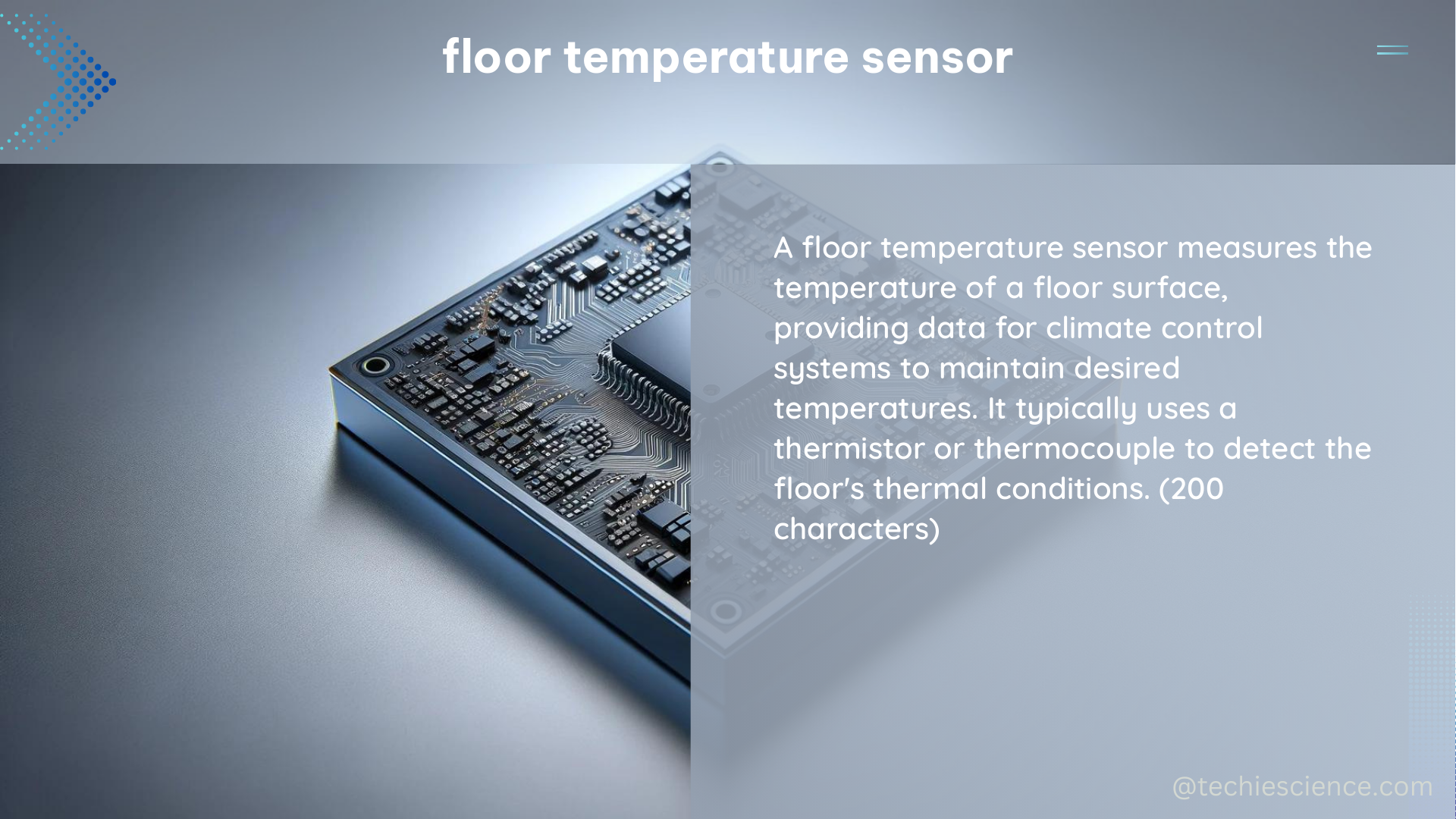The floor temperature sensor is a crucial component in heating systems, ensuring accurate temperature measurement and control. These sensors play a vital role in maintaining optimal comfort and energy efficiency in various residential and commercial settings. In this comprehensive guide, we will delve into the intricacies of floor temperature sensors, exploring their technical specifications, design considerations, and practical applications.
Understanding the Fundamentals of Floor Temperature Sensors
Floor temperature sensors are typically thermistors or resistance temperature detectors (RTDs) that measure the temperature of the floor surface. These sensors are designed to be embedded within the floor or installed on the surface, providing real-time temperature data to the heating system’s control unit. The sensor’s resistance value is directly proportional to the temperature, allowing the system to adjust the heating output accordingly.
One of the key factors that can significantly impact the temperature reading is the sensor’s resistance value. As demonstrated in a study, a 10 kΩ floor temperature sensor cable connected to a controller unit displayed a temperature around 7.0 °C higher than the actual temperature. This discrepancy highlights the importance of accurate sensor calibration and configuration to ensure reliable temperature measurements.
Flexible Temperature Sensors: The Future of Floor Temperature Monitoring

Advancements in material science have led to the development of flexible temperature sensors, which are particularly well-suited for floor temperature monitoring applications. These sensors are fabricated using a variety of carbon-based materials, including graphenes, carbon nanotubes, black carbon, and carbon fibers. These materials exhibit high sensitivity to temperature changes, making them ideal for precise temperature measurement.
The flexibility of these sensors is achieved through the use of flexible polymer substrates, such as polyimides, polyethylene terephthalates (PETs), and polydimethylsiloxanes (PDMSs). This allows the sensors to be seamlessly integrated into the floor surface, ensuring accurate temperature readings even on uneven or curved surfaces.
Integrating Floor Temperature Sensors with Arduino
In the case of a heated floor thermistor, the sensor should be readable based on an Arduino or similar platform. This requires a VCC (voltage supply) and an analog input pin to capture the sensor’s resistance value. As the temperature changes, the thermistor’s resistance value also changes, which can be converted into a temperature reading using appropriate programming and circuitry.
However, it’s important to note that issues with the sensor’s configuration or settings might result in inaccurate or unchanging readings, as seen in the discussion. To address this, it’s crucial to ensure proper sensor calibration and integration with the Arduino or control system.
Designing Temperature Sensors with Arduino: Key Specifications
When designing a temperature sensor using Arduino, there are several key specifications to consider:
-
Output Unit: The sensor should be able to predict the output in a common unit, such as the Celsius scale, for easy interpretation and integration with the heating system.
-
Accuracy Range: The sensor should have an accuracy range of at least ±0.5°C to ensure precise temperature measurement.
-
Temperature Range: The sensor should be capable of operating within a wide temperature range, typically from -55°C to 150°C, to accommodate various heating system requirements.
-
Linear Scale Factor: The sensor should have a linear scale factor of around 10 mV/°C, allowing for a straightforward conversion of the sensor’s output to temperature values.
Adhering to these specifications is crucial for achieving accurate temperature measurement and control, enabling efficient and reliable heating system operation.
Troubleshooting and Calibration of Floor Temperature Sensors
In some cases, users may encounter issues with the floor temperature sensor, such as inaccurate or unchanging readings. To address these problems, it’s essential to follow a systematic troubleshooting process:
-
Sensor Connectivity: Ensure that the sensor is properly connected to the control unit or Arduino, with the VCC and analog input pins functioning correctly.
-
Sensor Resistance Verification: Use a multimeter to measure the sensor’s resistance value and compare it to the expected resistance range based on the temperature. This can help identify any issues with the sensor’s resistance.
-
Sensor Calibration: If the sensor’s resistance value is not within the expected range, perform a calibration procedure to adjust the sensor’s output to match the actual temperature.
-
Sensor Replacement: If the sensor is found to be faulty or unable to be calibrated, consider replacing the sensor with a new one to ensure accurate temperature measurements.
By following these troubleshooting steps and maintaining proper sensor calibration, you can ensure the reliable operation of your floor temperature sensor and optimize the performance of your heating system.
Conclusion
Floor temperature sensors are essential components in heating systems, providing accurate temperature measurement and control. The integration of flexible temperature sensors made from carbon-based materials has further enhanced the capabilities of these sensors, enabling precise monitoring on various floor surfaces.
By understanding the technical specifications, design considerations, and troubleshooting techniques for floor temperature sensors, you can ensure the efficient and reliable operation of your heating system. This comprehensive guide has provided you with the necessary knowledge and tools to master the art of floor temperature sensor management, empowering you to create comfortable and energy-efficient living or working environments.
References:
- Fabrication of flexible temperature sensors to explore indeterministic data analysis for robots as an application of Internet of Things
- How to correct/adjust floor temperature sensor resistance to account for calibration
- Sensors for daily life: A review – ScienceDirect.com
- Help getting reading from heated floor thermistor : r/shellycloud
- Arduino – Temperature Sensor – GeeksforGeeks

The lambdageeks.com Core SME Team is a group of experienced subject matter experts from diverse scientific and technical fields including Physics, Chemistry, Technology,Electronics & Electrical Engineering, Automotive, Mechanical Engineering. Our team collaborates to create high-quality, well-researched articles on a wide range of science and technology topics for the lambdageeks.com website.
All Our Senior SME are having more than 7 Years of experience in the respective fields . They are either Working Industry Professionals or assocaited With different Universities. Refer Our Authors Page to get to know About our Core SMEs.